7 Best Wineries In Tuscany, Italy
Even before getting involved in the wine world, Tuscany had always been a region associated with the culture of the land, grapes, and top-quality wine. After traveling through the region several times and experiencing some
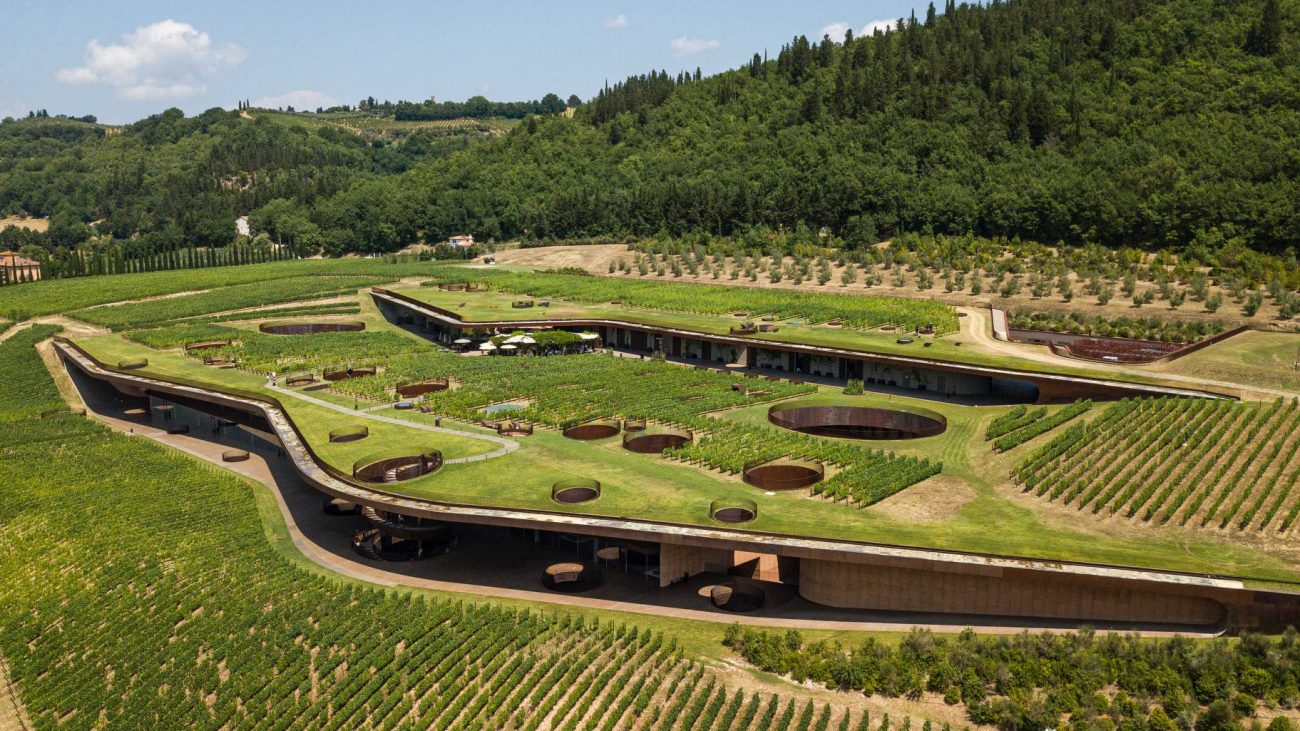
Even before getting involved in the wine world, Tuscany had always been a region associated with the culture of the land, grapes, and top-quality wine. After traveling through the region several times and experiencing some really great Chianti wine tours and tastings at some of its most revered wineries, we can confidently say it’s one of the best places in the world for a wine getaway.
Visiting Tuscan wineries is all about wine, but it’s also a full experience that packs incredible food, rich history, and breathtaking scenery all in one. This is a guide for fellow wine and food lovers who want to experience Tuscany authentically, with tips on where to find the region’s best wineries. We’ve rounded up seven best wineries in Tuscany which, in our opinion, offer the ultimate Tuscan experience. These are the places you’ll want to start with if you’re planning to visit one of the most famous wine-producing areas in Italy (and in the world, we dare to say!)
Best Wineries in Tuscany
Tuscany is home to many renowned wineries, but there are a few that truly stand out. These estates have put Tuscan wines on the global map, consistently producing exceptional bottles that reflect the region’s rich history and innovative spirit. Let’s dive into my top picks, which have personally wowed us with their wines and experiences.
Antinori, Chianti Classico
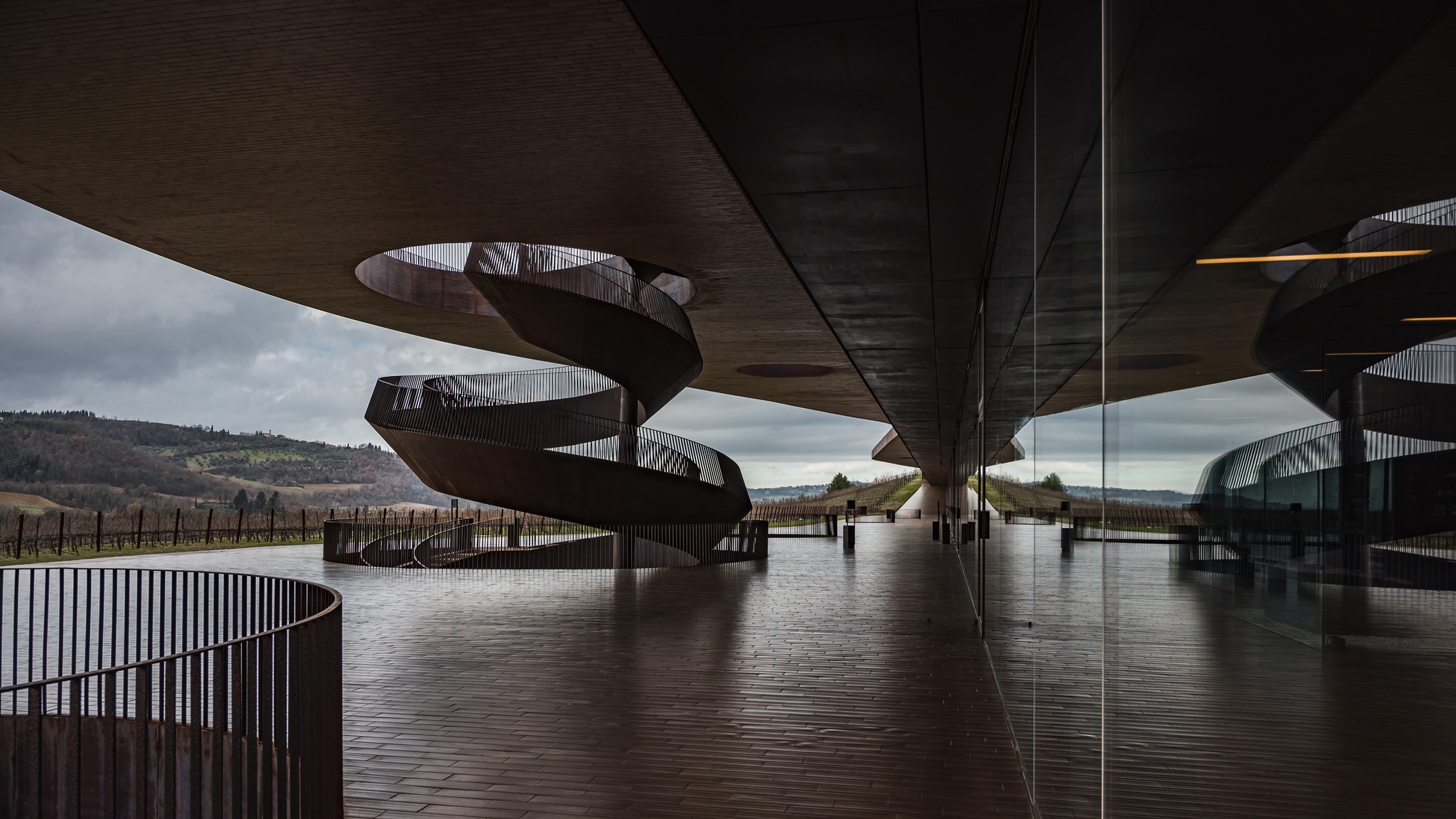
Photo credit: Antinori Chianti Classico
The Antinori family has been making wine for over 600 years, and they’ve been one of the most influential names in Italian wine history. Their flagship estate in Chianti Classico is a modern architectural masterpiece. The sleek, contemporary design of the winery blends seamlessly with the rolling hills of vineyards, providing a unique contrast between old-world tradition and new-world innovation.
Why Visit Antinori Chianti Classico?
First of all, the location itself is absolutely stunning. You’ll find the Antinori Chianti Classico winery located in the rolling hills of Tuscany, about 20 km from Florence and right off the highway that leads to Siena. While the surrounding countryside of vineyards and olive groves is very traditional, the winery itself is anything but.
Designed by renowned architect Marco Casamonti, the building is sleek, modern, and blends so naturally into the Tuscan landscape that it almost disappears. Most of the structure is built underground to maintain harmony with the environment, and this helps create ideal conditions for the wine aging process.
When we first arrived, we were struck by the contrast: this ultra-modern building tucked into ancient, serene hills. The winery looks like a perfect slice carved out of the landscape, with a long, curving iron spine that’s as much a part of the building’s architecture as it is a testament to the winery’s forward-thinking philosophy. If you appreciate innovative architecture alongside winemaking, this is definitely worth a visit. But even if you’re here purely for the wine, you won’t be disappointed.
What to Do at the Antinori Chianti Classico
The winery offers several guided tours, each providing a unique insight into the Antinori family’s winemaking traditions, their modern innovations, and of course, the wines themselves. We’d suggest booking ahead because the tours, especially in English, fill up quickly.
- The Tinaia Tour is a great introduction for those looking to understand the basics of Antinori’s winemaking process, including a stroll through their innovative barrel rooms and a short documentary that details the family’s history. It’s a well-rounded 90-minute experience where you get to taste three wines, usually from different Antinori estates. If you’re traveling with kids, this tour is ideal since it’s not too long and children are welcome.
- For serious wine lovers, though, I highly recommend the Bottaia Tour. This is a more in-depth tour that dives into the winery’s more exclusive spaces and production areas. The highlight here is the tasting room, suspended above the cellar, where you’ll get to sample four wines, including some of their premium offerings like Villa Antinori Chianti Classico DOCG Riserva and the bold Bramasole Syrah from Cortona. You also get access to their art collection, which is a bonus if you’re into Italian art and culture. It’s a full two-hour experience, and it’s definitely worth the €70 price tag.
- If you really want to go all out, the Cru Tour is the ultimate deep dive into Antinori’s most prestigious wines, paired with a multi-course lunch at the rooftop restaurant, Rinuccio 1180. This is where you’ll taste wines like the famous Tignanello (one of Italy’s first Super Tuscans) and Badia a Passignano Gran Selezione Chianti Classico. The lunch alone is worth the trip—the food is incredible, and you’re surrounded by floor-to-ceiling windows offering panoramic views of the Tuscan hills. It’s a bit pricey at €180 per person, but if you’re celebrating a special occasion or just want an unforgettable experience, this is the way to go.
What Wines to Try at Antinori Chianti Classico
Antinori is one of Tuscany’s most famous winemakers, and for good reason—they produce everything from everyday Chianti to some of Italy’s most iconic wines. Here’s a quick rundown of what to try during your visit:
- Tignanello – This is probably the most famous wine produced by Antinori, and it’s a must-try if you’re at the winery. A blend of Sangiovese, Cabernet Sauvignon, and Cabernet Franc, it’s one of Italy’s first Super Tuscans. It’s bold, complex, and absolutely worth savoring.
- Villa Antinori Chianti Classico DOCG Riserva – This classic Chianti embodies everything you’d expect from a top-tier wine in the region: vibrant red fruit, balanced acidity, and just enough tannins to make it perfect for pairing with food.
- Solaia – Another Super Tuscan, Solaia is a blend of Cabernet Sauvignon, Sangiovese, and Cabernet Franc. It’s a bit more opulent and full-bodied than Tignanello, with darker fruit notes and a longer aging potential. If you’re a fan of rich, structured reds, don’t miss this one.
- Bramasole Syrah – From their Cortona estate, this Syrah is something special. It’s rich, spicy, and a bit different from the Sangiovese-dominated wines of the region. Definitely worth trying if you like bold reds with a lot of character.
- Cont’Ugo Bolgheri DOC – This is an excellent choice if you enjoy Bordeaux-style blends. Made primarily from Merlot, it’s lush and smooth with a mix of red and dark fruit flavors. It’s an approachable wine, perfect for those who are new to Italian wines.
Practical Tips for Visiting Antinori Chianti Classico
- Book Ahead: Whether you’re planning on taking a tour or just tasting some wines, I can’t stress enough how important it is to book ahead. The winery gets busy, especially during high tourist season.
- Allow Time to Explore: This isn’t a quick stop. Between the tours, the art collection, and the restaurant, plan to spend at least half a day here. And don’t forget to leave time to explore the wine shop—Antinori bottles are available to taste and buy, including some that you might not easily find outside of Italy.
- Stay for Lunch: If you can, we’d strongly recommend staying for lunch at Rinuccio 1180. The views are stunning, and the food—fresh, local, and seasonal—perfectly complements the wines. Try the Chianti burger if you’re looking for something hearty yet refined.
- Combine with a Visit to Florence or Siena: Given its location, the winery makes an easy day trip from either Florence or Siena. I’d suggest combining it with some sightseeing in one of these cities for a full day of Tuscan exploration.
Castello di Ama
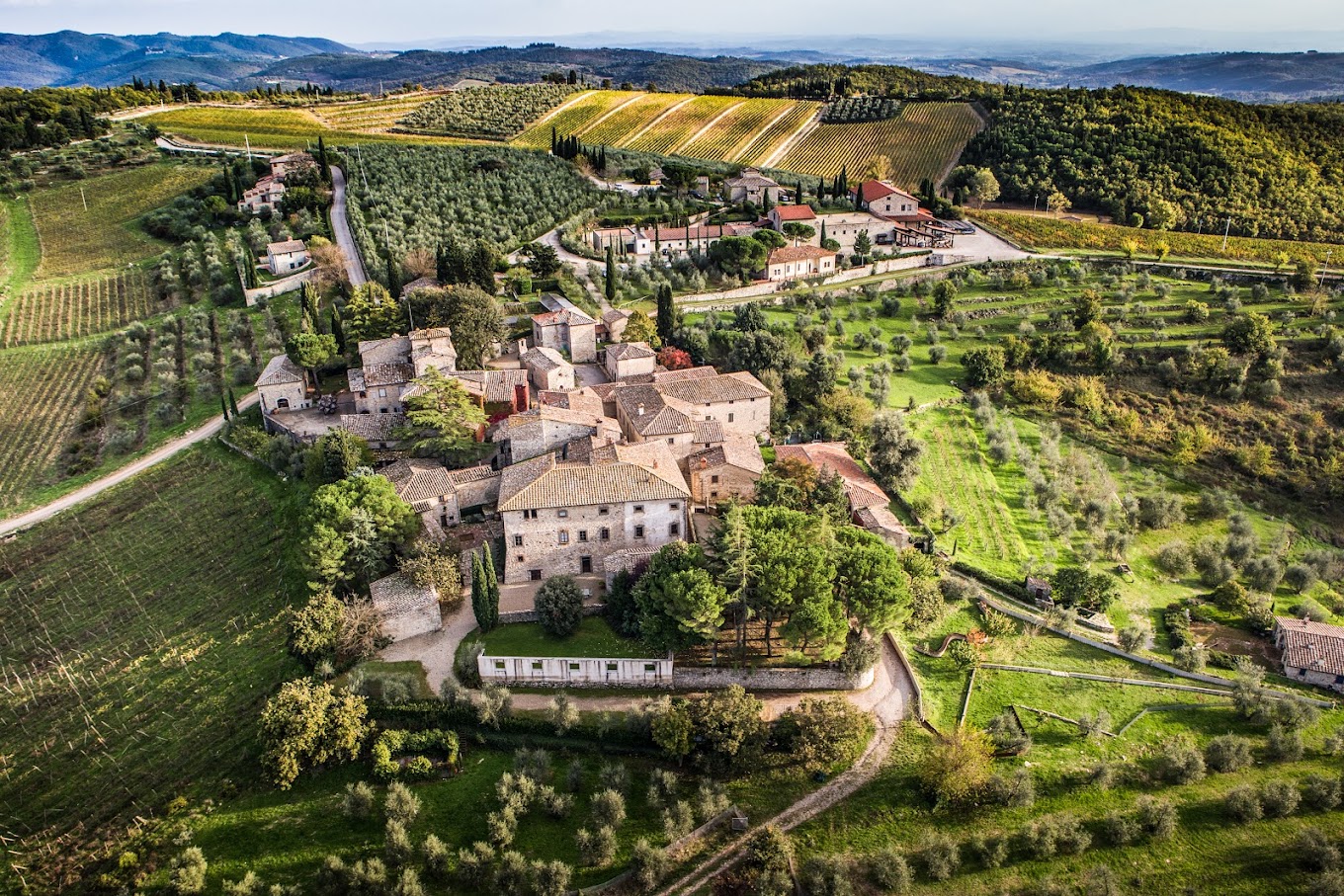
Photo credit: Castello di Ama
Located in a medieval hilltop village north of Siena, Castello di Ama is a perfect combination of wine, art, and history. The estate is known not just for its top-notch wines, but also for its commitment to contemporary art. It’s the kind of place that leaves an impression. One you’ll undoubtedly want to share with friends who appreciate life’s finer things.
Why Visit Castello di Ama?
The estate, dating back to the 12th century, sits in the heart of the Chianti Classico wine region, and it offers a rare mix of ancient history world-class wines and modern elegance. Sure, many Tuscan vineyards are charming, but Castello di Ama brings a unique twist: contemporary art. As you wander through the vineyard and olive groves, you’ll come across installations that both surprise and complement the natural beauty around you. You’ll find thought-provoking installations from artists like Anish Kapoor and Daniel Buren. It’s like walking through a living art gallery with vineyards as a backdrop.
What to Do at Castello di Ama
At Castello di Ama, the wine and art are the stars, but there’s plenty to do to keep you captivated for hours.
- Wine Tasting and Tours: The estate offers several types of guided tours, which we highly recommend. You’ll stroll through the vineyards, explore the medieval hamlet, and then finish with a tasting of their finest wines. If you’re short on time, opt for the Journey to Ama tour. It’s about an hour and a half and includes a tasting of three of their standout wines: the Montebuoni Chianti Classico Riserva, the Haiku (a super Tuscan blend), and the estate’s flagship Castello di Ama San Lorenzo Chianti Classico Gran Selezione.
- Art Tour: If art is your passion, spend extra time exploring the installations. We found the interplay between modern art and the traditional Tuscan setting fascinating.
- Olive Oil Tastings: Castello di Ama also produces some of the best extra virgin olive oil we’ve ever tasted. After the tasting, we suggest grabbing a bottle or two as a souvenir.
- Dining at Il Ristoro di Ama: If you can, don’t leave without dining at Il Ristoro di Ama, the estate’s on-site restaurant. The setting – in a beautifully restored Tuscan house – is intimate and elegant. You’ll enjoy a meal prepared with locally sourced ingredients, all paired with Castello di Ama wines.
- Stay in the Suites: If you’re really looking to indulge, consider staying in one of the five suites at Villa Ricucci, the estate’s 18th-century manor house. Each suite is named after one of the vineyards and offers stunning views and luxurious amenities. It’s not a hotel stay – it’s more like being welcomed into an exclusive, private retreat where time seems to slow down.
What Wines to Try at Castello di Ama
Now, let’s talk wine. Castello di Ama produces some of the finest wines in the region, and their tastings offer a curated experience of their top selections. Here’s what we recommend trying:
- Castello di Ama San Lorenzo Chianti Classico Gran Selezione: This is their flagship wine and a true expression of the Chianti Classico terroir. Rich, structured, and elegant, it’s the kind of wine you’ll want to savor slowly. We found it had layers of dark fruit, spices, and a hint of earthy complexity that speaks to its aging potential.
- L’Apparita: If you’re a fan of Merlot, don’t miss this one. L’Apparita is one of Tuscany’s first 100% Merlot wines, and it’s become an iconic label in the world of fine wine. It’s powerful yet graceful, with intense flavors of black cherry, plum, and a touch of chocolate. It’s not an everyday wine – it’s a showstopper.
- Haiku: A super Tuscan blend of Sangiovese, Merlot, and Cabernet Franc, Haiku is a more modern, international take on Tuscan wine. It’s fresh and vibrant with a balance of fruit and acidity that makes it a delight to drink. This was one of my personal favorites because of its versatility and food-friendliness.
- Vigneto Bellavista and Vigneto La Casuccia: These are their single-vineyard Chianti Classicos, and they’re only produced in exceptional years. If you have the chance to try them, don’t hesitate. Both are bold, complex, and full of character, showing just how expressive Sangiovese can be when grown in the right terroir.
Practical Tips for Visiting Castello di Ama
- Book Ahead: Tours and tastings are by appointment only, so make sure you book ahead. The estate is popular, especially during peak season, so reserve your spot early.
- Take Your Time: You’ll want to set aside at least a half-day for your visit to Castello di Ama. Between the art, the wine, and the incredible views, it’s not the kind of place you want to rush through.
- Wear Comfortable Shoes: There’s a bit of walking involved, especially if you’re taking a full tour of the estate and art installations. Comfortable shoes will make all the difference.
Castello di Nipozzano
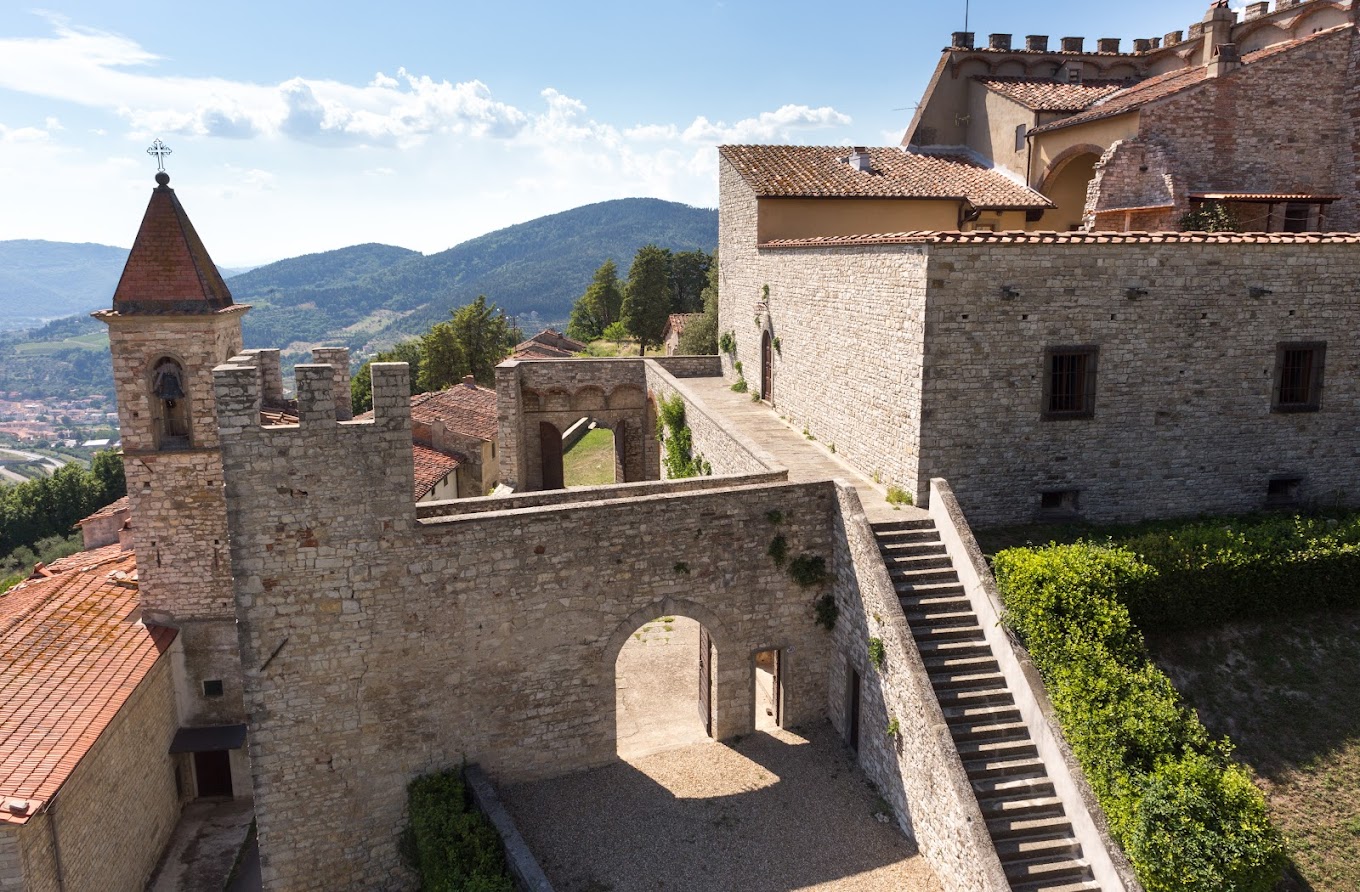
Photo credit: Castello di Nipozzano
Frescobaldi is another historic family in Tuscany, and their Castello di Nipozzano estate is one of their crown jewels. Located in the Rufina subregion of Chianti, Nipozzano is a stronghold of tradition emphasizing quality. Located just 20 minutes outside Florence, in the Chianti Rufina region, this 1,000-year-old estate is one of Tuscany’s must-visit wineries.
Why Visit Castello di Nipozzano?
Originally built to defend Florence, this castle still retains much of its medieval charm, with stone walls and ancient cellars that tell tales of centuries-old winemaking. The castle sits high on a hill, offering stunning panoramic views of the Arno River Valley and surrounding vineyards. Honestly, the landscape alone is worth the trip. The views are picture-perfect, especially in the golden light of the late afternoon.
What makes the experience even better is knowing you’re walking in the footsteps of Renaissance artists like Donatello and Michelozzo Michelozzi, who used to purchase wine from this very estate. That’s the kind of history you can’t fabricate—there’s an authenticity here that feels tangible.
But don’t expect a place frozen in time. Nipozzano is a working farm—more than 600 hectares (around 1,500 acres) of vineyards and olive groves. You’ll even see Chianina and Angus cattle grazing freely on the property. This is the real deal, an active agricultural estate that embraces both tradition and modernity.
What to Do at the Castello di Nipozzano
- Tour the Monumental Cellars: These ancient, underground cellars have been aging Chianti Rufina wines for centuries. Walking through them is like stepping into another time, surrounded by oak barrels and the history of Tuscan winemaking.
- Wine Tasting in the Old Kitchen: The tasting room is located in what was once the castle’s kitchen, giving the experience an intimate, rustic feel. Knowledgeable staff guides you through each wine’s history, characteristics, and tasting notes.
- Explore the Working Farm: Beyond the vineyards, you’ll see olive trees, Chianina and Angus cattle, and more, showcasing the estate’s wide agricultural activity.
- Sample Estate-grown Olive Oil: Don’t miss the chance to taste the estate’s exceptional extra virgin olive oil, produced on-site from their olive groves.
- Attend Customizable Private Events: Whether it’s a special occasion or a personalized experience, Castello di Nipozzano offers private events tailored to your preferences (booking in advance is a must).
- Purchase Old Vintages: If you’re a collector or simply curious, the estate offers older vintages of their wines, some dating back to 1864. Special recommendations include vintages from 1960, 1974, and 1981.
What Wines to Try at Castello di Nipozzano
Now, let’s get to the star of the show: the wines. Nipozzano is part of the Chianti Rufina appellation, which is known for producing wines that are a bit more refined and structured than your average Chianti. The higher altitude of the vineyards here adds freshness and complexity to the wines. We highly recommend trying a few standouts:
- Nipozzano Riserva Chianti Rufina DOCG: This is the estate’s flagship wine, and it’s absolutely stellar. Aged for 24 months in oak barrels, it’s an elegant, well-balanced red with notes of cherry, plum, and a touch of spice. For lovers of traditional Chianti, this one’s a must-try.
- Mormoreto Toscana IGT: Mormoreto is the estate’s iconic Super Tuscan blend, made from Cabernet Sauvignon, Merlot, Cabernet Franc, and Petit Verdot, with a splash of Sangiovese in more recent vintages. If you’re into bold, full-bodied reds, this wine will blow you away. It’s deep, rich, and layered with flavors like black currant, tobacco, and dark chocolate. Perfect for aging or enjoying now with a robust meal.
- Montesodi Chianti Rufina Riserva DOCG: If you’re after something a bit more special, ask for the Montesodi. This single-vineyard Sangiovese is outstanding. It’s produced from stony soil which gives it an extra level of complexity and minerality. It’s powerful yet elegant, with vibrant acidity and flavors of red fruit, herbs, and earthy notes.
For collectors, there’s also the chance to purchase old vintages. The Frescobaldi family has bottles dating back to 1864, but if you ask the current head of the family, Marchese Lamberto Frescobaldi, he’ll tell you he’s particularly fond of the 1960, 1974, and 1981 vintages. If you’re looking for a piece of history to take home, you might just find it here.
Practical Tips for Visiting Castello di Nipozzano
- Farm-to-table dining: Although there isn’t a formal restaurant, you can arrange for a meal on the property. Enjoy dishes made from locally sourced ingredients grown right on the estate. Be sure to request this in advance.
- Exclusive stays: For a truly immersive experience, book one of the castle’s few exclusive rooms. Waking up to views of the Chianti Rufina vineyards is something special, and you can even enjoy a hot tub with panoramic views.
- Book in advance: Whether for tours, tastings, or meals, reservations are essential. This ensures a personalized and seamless experience.
- Close to Florence: Castello di Nipozzano is just a 20-minute drive from Florence, making it an easy day trip or a charming weekend getaway in Tuscany.
- Enjoy Tuscan views: The estate offers some of the best panoramic views of the Arno River Valley and surrounding vineyards. Take some time to just relax and soak in the beauty.
Prima Pietra, Riparbella
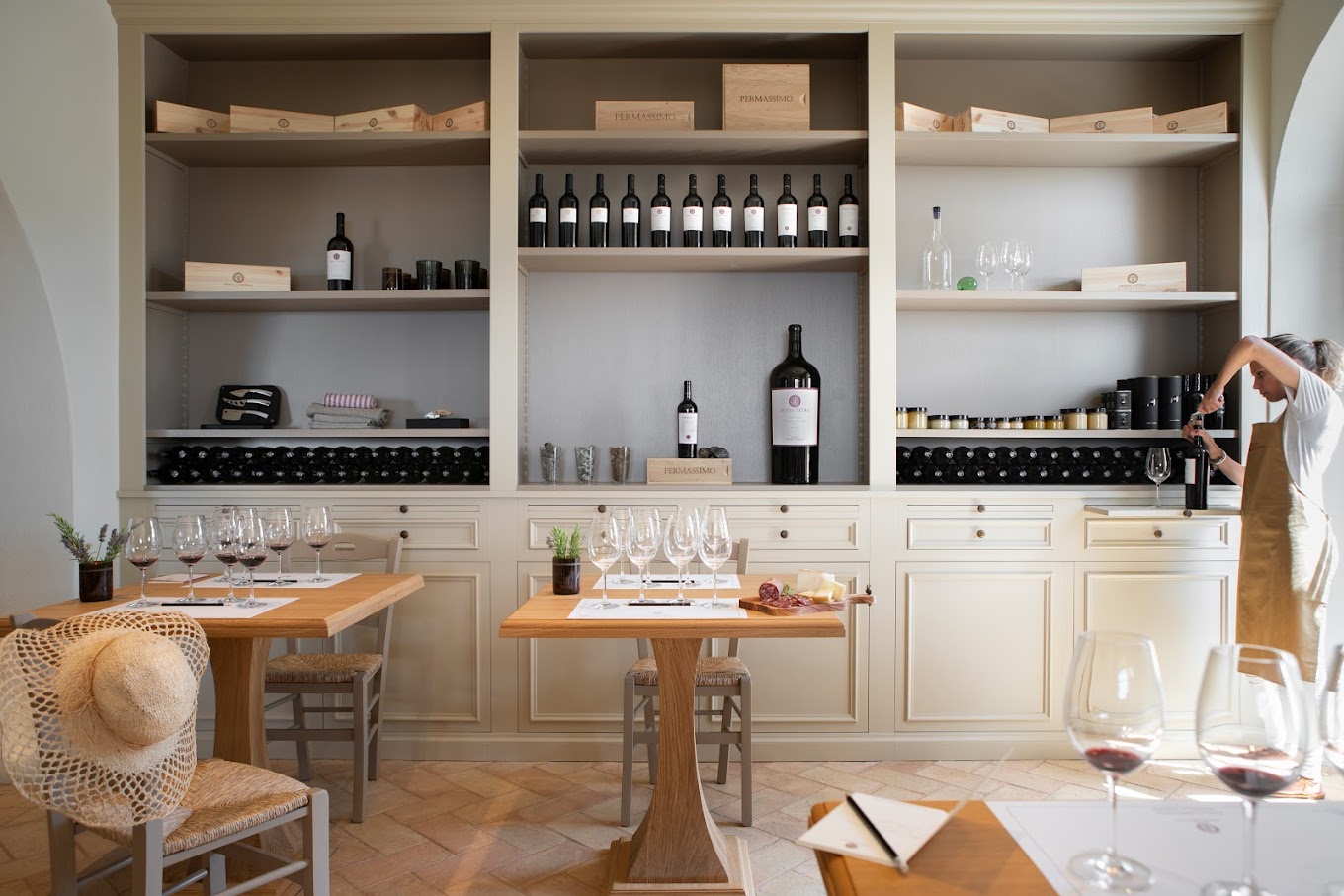
Photo credit: Tenuta Prima Pietra
If you’re a wine enthusiast looking for a quieter, more intimate escape from the bustling tourist scene in Bolgheri, then Tenuta Prima Pietra in Riparbella is where you need to go. Prima Pietra is a relatively new winery, but it has quickly made a name for itself with its exceptional Bordeaux-style blends. This remote vineyard, perched high in the hills with panoramic views of the Tuscan coast, is a tranquil haven for those who appreciate both fine wine and breathtaking landscapes.
Why Visit Tenuta Prima Pietra?
The first thing you notice upon arriving is the incredible sense of peace. Unlike Bolgheri, which can sometimes feel crowded with cyclists and tourists, Riparbella is a refreshing contrast. The road leading to Tenuta Prima Pietra winds through the quiet, picturesque town and up to the estate’s gates, where you’re greeted by sweeping views of the Tyrrhenian Sea and the islands of Elba and Capraia on clear days. It’s easy to feel like you’ve discovered a secret pocket of Tuscany that few have the pleasure of experiencing.
The setting is incredible. Located at 450 meters above sea level, Prima Pietra is the highest vineyard on the Tuscan coast. The altitude, constant sea breezes, and dramatic temperature changes between day and night allow the grapes to develop slowly and beautifully, resulting in wines of complexity and elegance.
The vineyard itself is an organic oasis, surrounded by wild Mediterranean vegetation, with soils rich in fossils, minerals, and iron clays. The estate follows a philosophy of minimal intervention in the vineyard. This hands-off, respectful approach to viticulture has earned them organic certification since 2016, but they’ve been working towards it long before that.
Now, let’s talk about the wine. Tenuta Prima Pietra specializes in Bordeaux-style blends, and they’ve been crafting elegant wines here since 2007 under the guidance of Massimo Ferragamo—yes, of the Ferragamo fashion dynasty. It’s worth noting that this was Ferragamo’s first winery purchase, and the passion and care poured into each bottle reflect his commitment to quality winemaking.
What to Do at Tenuta Prima Pietra
Your visit to Tenuta Prima Pietra will be both educational and indulgent. Here’s what we recommend:
- Wine Tour & Tasting: Begin with a stroll through the vineyards, often with a glass of their crisp whites in hand (talk about a perfect start!). One of the estate’s knowledgeable hosts. Afterward, you’ll visit the fermentation room and cellar, where you’ll see their French oak barrels aging these exceptional wines.
- Vertical Tasting of Super Tuscans: Prima Pietra offers a vertical tasting of their wines, where you can sample different vintages side by side, allowing you to appreciate how each year’s climate and conditions have influenced the wine. The tasting is held in an outdoor space with unbeatable views of the coast. We recommend trying their Prima Pietra Bordeaux blend, which combines Merlot, Cabernet Sauvignon, Cabernet Franc, and Petit Verdot, as well as Permassimo, a limited-production wine made entirely from Cabernet Franc.
- Back-Vintage Tastings: If you’re into rare wines, Prima Pietra offers tastings of older vintages. This is a fantastic way to explore how their wines develop over time. Wines like Prima Pietra age beautifully, becoming more complex and layered, with silky tannins and deep fruit flavors balanced by spicy notes.
- Food Pairing Experience: There’s no restaurant at the estate, but if you book ahead, you can request a delicious plate of local cheeses, cold cuts, fresh bread, their own extra virgin olive oil, and honey. It’s the perfect way to savor the wines alongside authentic Tuscan flavors.
- Cooking Classes: For those wanting to immerse themselves in Tuscan culinary traditions, Tenuta Prima Pietra offers cooking classes where you’ll prepare a four-course meal using fresh ingredients from the estate’s garden. Afterward, you’ll sit down to enjoy your meal, paired with four of their wines, all while soaking in the panoramic views from the terrace.
Wines to Try at Tenuta Prima Pietra
- Prima Pietra: The estate’s signature wine, a Bordeaux blend of Merlot, Cabernet Sauvignon, Cabernet Franc, and Petit Verdot. What we love about this wine is its elegance—on the nose, you’ll find ripe red berries mixed with subtle spicy notes, and in the mouth, it’s full-bodied yet balanced, with soft tannins and a long finish. The altitude of the vineyards gives it great freshness, making it a vibrant and refined Super Tuscan.
- Permassimo: This is a wine for serious wine lovers. Made entirely from Cabernet Franc, Permassimo is rich and layered, with notes of blackberries, plums, and violets. The wine is beautifully structured with velvety tannins and has a freshness that makes it incredibly drinkable, even when young. This one is perfect for aging if you have the patience, but it’s also a pleasure to drink now.
- Vertical Tasting Kit: If you can’t decide on a single vintage, you can purchase a vertical tasting kit that includes several vintages of Prima Pietra. It’s a fantastic way to experience the evolution of this wine, and the winery even offers a private live tasting session with one of their wine experts to guide you through the experience.
Practical Tips for Visiting Tenuta Prima Pietra
- Book Ahead: Tours and tastings are by appointment only, and it’s wise to book in advance to ensure you get a spot, especially for the cooking class or any special tastings.
- Best Time to Visit: Spring and fall are ideal, as the weather is perfect for strolling the vineyards, and the views of the Tuscan coast are at their most stunning.
- Getting There: The estate is about an hour’s drive from Pisa or an hour and a half from Florence. It’s a scenic drive, and you’ll want to have a car to fully explore the surrounding area.
- Take Your Time: Don’t rush your visit. Tenuta Prima Pietra is a place to slow down, enjoy the landscape, and immerse yourself in the wine. Plan to spend a few hours here, sipping wine and soaking in the views. Combine your visit with a trip to nearby Bolgheri and Ornellaia, two other coastal gems. The contrast between the coastal and inland wines of Tuscany is fascinating.
Col d’Orcia, Montalcino
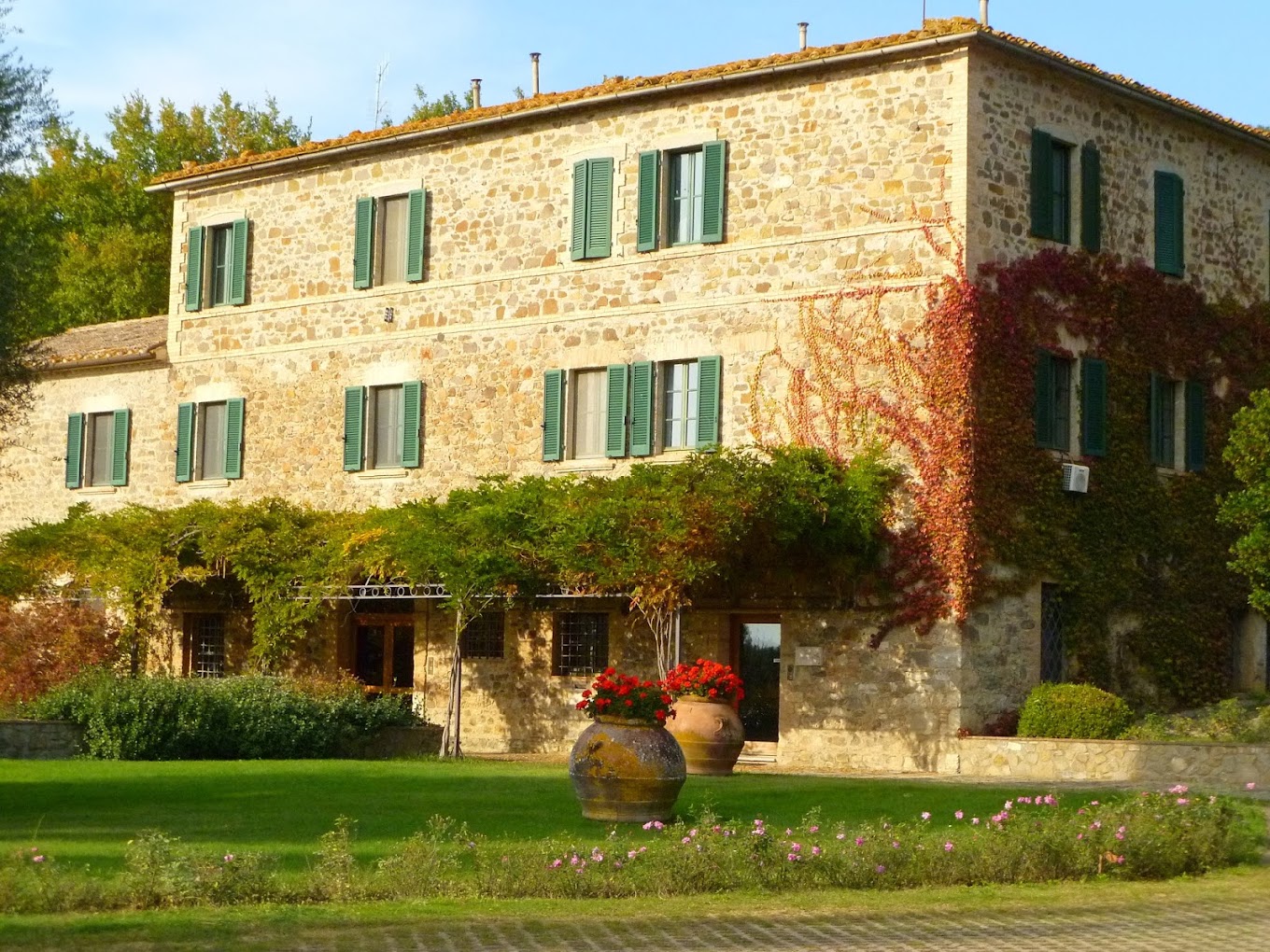
Photo credit: Col d’Orcia
Col d’Orcia is one of the oldest and most respected estates in Montalcino, home of the world-renowned Brunello di Montalcino. Visiting the estate is an experience that feels like stepping into a time capsule, far removed from the polished, more modern wineries that dot the landscape.
Why Visit Col d’Orcia?
Let’s be real – when it comes to Tuscan wineries, you’re spoiled for choice. But Col d’Orcia stands out in its unique way. Unlike some of the sleeker, more commercialized wineries (Castiglion del Bosco for example!), this place has an old-world charm. Think rustic and intimate, with a tasting room that could easily double as the Cinzano family’s dining room. It’s got that cozy vibe, complete with family portraits on the walls and a large dining table where tastings take place.
So, why should you visit Col d’Orcia? If you’re a fan of organic wines, historical estates, or just enjoy soaking in the atmosphere of a place that feels truly authentic, this winery offers just that. The estate itself is the largest certified organic farm in Tuscany. They’ve been fully organic since 2010.
First off, there’s a range of tours and experiences to choose from. The tours typically start with a stroll through the estate, giving you a firsthand look at the vineyards and olive groves. The estate’s organic farming methods are based on biodynamic principles, which add an extra layer of care to how the vines are treated and how the wine ultimately comes to life.
You can opt for the “Classic Wine Tour” where you’ll get to try the latest releases, including their flagship Brunello di Montalcino. If you’re more into rarer wines, their “Brunello Old Vintage Experience” lets you taste some of the estate’s most coveted bottles.
For true wine enthusiasts, there are VIP tours that include tastings straight from the barrel, followed by a light or full lunch. These lunches are an experience in themselves, as everything served is fresh from the estate. Think farm-to-table Tuscan fare. It’s intimate, it’s elegant, and it’s the kind of lunch you’ll be telling your friends about for years.
What to Do at Col d’Orcia
Here’s a breakdown of the main activities you can enjoy at the estate:
- Take a Guided Tour: Walk through the estate’s organic park and vineyards while learning about their biodynamic farming practices.
- Explore the Cellars: A behind-the-scenes look at their traditional winemaking process. The cellar tour often includes tastings straight from the barrels.
- Wine Tastings: You can opt for:
- The Classic Wine Tour, where you’ll try their latest releases, including the famous Brunello di Montalcino.
- The Brunello Old Vintage Experience gives you a chance to taste older vintages, along with local meats and cheeses.
- The VIP Tour: If you’re feeling fancy, go for the VIP tour, which ends with a light or full lunch featuring fresh ingredients from the farm, paired with six or more of their finest wines.
- Try Local Tuscan Antipasti: For an extra fee, you can add a delicious plate of local cured meats, cheeses, and fresh bread to your tasting.
- Shop for Wines and Organic Goods: Their on-site shop offers their exceptional wines, older vintages, and organic products like olive oil, honey, and even pasta made from wheat grown on the estate.
What Wines to Try at Col d’Orcia
Of course, you can’t visit a winery like Col d’Orcia without diving headfirst into their incredible wines. Here are some standout recommendations:
- Brunello di Montalcino – This is the crown jewel of Col d’Orcia and one of the reasons why wine lovers from all over the world flock to this estate. Made from 100% Sangiovese, the Brunello is aged for three years in large oak barrels and then another year in the bottle before release. The result is a beautifully balanced wine with rich, earthy notes, and a complex structure that will only improve with age.
- Poggio al Vento Brunello di Montalcino Riserva – If you’re lucky enough to visit when this is available, don’t miss it. Made from a specific vineyard on the estate (Poggio al Vento means “Windy Hill”), this wine is aged even longer – four years in large oak barrels followed by three years in the bottle. It’s powerful yet elegant, with tannins that are firm but refined. This is a wine that’s built to last and is one of the highest expressions of Sangiovese you’ll find in the region.
- Sant’Antimo – This DOC includes a range of styles, but Col d’Orcia’s version is particularly noteworthy. It’s often overshadowed by Brunello, but don’t sleep on this one. It’s a fresher, lighter wine that’s perfect for summer days or when you want something a bit more approachable but still packed with flavor.
- Moscadello di Montalcino (Pascena) – A late-harvest dessert wine that dates back to the Renaissance. This sweet wine is something special, bursting with apricot, peach, and citrus notes. It’s the perfect way to end a meal, especially when paired with cheese or biscotti.
- Gineprone Chianti – If you’re looking for something a bit different, this Chianti has a Mediterranean flair with hints of herbs and spices. It’s a more casual wine but still delivers in terms of flavor and complexity.
Practical Tips for Visiting Col d’Orcia
Here are some handy tips to make the most of your visit to Col d’Orcia:
- Book in Advance: The tours, especially the ones that include lunch or more elaborate experiences, require reservations. Book at least a week ahead during peak season.
- Tour Costs: Tours start at €15 for a basic visit, with higher-end experiences (including full lunches and tastings of older vintages) costing up to €100 per person.
- Opening Hours: Col d’Orcia is open Monday to Saturday, from 9:00 AM to 12:30 PM, and again from 2:30 PM to 5:00 PM. The wine shop follows similar hours.
- Lunch Options: While there isn’t a full restaurant on-site, Col d’Orcia can arrange an antipasto plate or full lunch for visitors who book in advance. All ingredients are organic and sourced directly from the estate.
- Don’t Skip the Wine Shop: After your tour, make sure to visit their shop to pick up some bottles to take home. You can also buy their organic products like olive oil, pasta, and honey.
- Taste Older Vintages: If you’re a fan of aged wines, opt for the tours that allow you to taste back vintages, and don’t hesitate to buy a bottle of Brunello that’s ready to drink now.
Monteverro, Capalbio
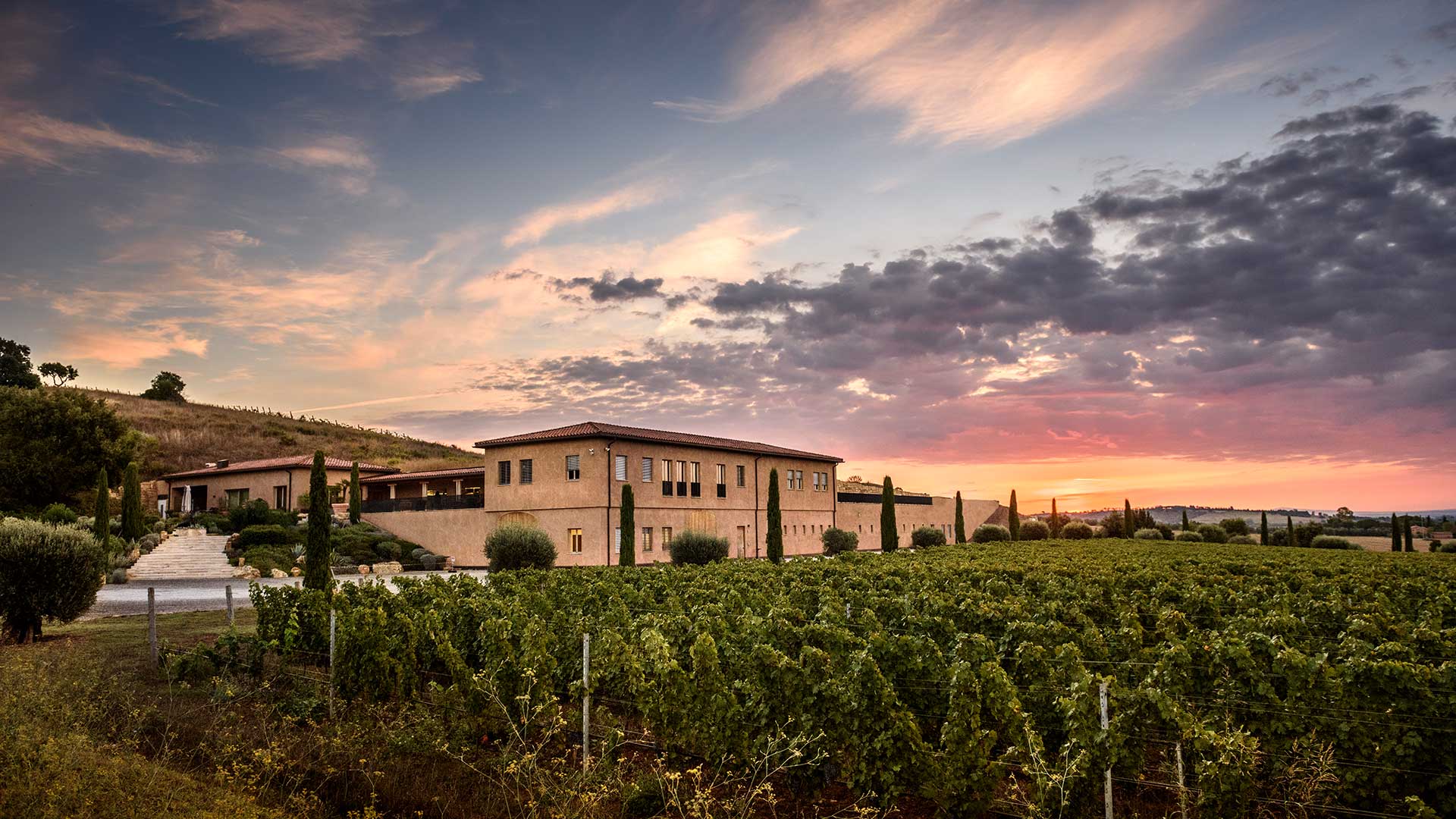
Photo credit: Monteverro
Monteverro is located in the southern part of Tuscany, near the town of Capalbio. This relatively young winery has quickly gained a reputation for producing world-class wines, particularly its Super Tuscans. Unlike the older, more established vineyards, Monteverro is about exploration and innovation. It’s a place where a love of Bordeaux varietals meets the wild, untamed landscape of Maremma, and the result is nothing short of spectacular.
Why Visit Monteverro?
When you think of Tuscan wineries, the images that likely come to mind are ancient vineyards, rustic cellars, and time-honored traditions. Monteverro is a departure from that classic narrative but in the best possible way. The winery was founded in 2003 by Julia and Georg Weber, and their goal is simple but ambitious: to create world-class wines that can rival the finest from Bolgheri and Bordeaux.
Located about an hour south of Grosseto and not far from the beautiful beaches of Monte Argentario, Monteverro is a modern winery that embraces the local terroir while pushing the boundaries of what Tuscan wine can be.
What to Do at Monteverro
Here’s what you can expect to do when you visit Monteverro:
- Take a Guided Tour: The tour, which costs €65, offers a deep dive into the wine-making process at Monteverro. You’ll start with a walk through the vineyards, where the unique terroir of red clay and rocky soil is explained. The steep slopes and proximity to the sea play a significant role in the quality of the grapes, and you’ll see firsthand how the team here works to maintain that balance.
- Visit the Barrel Room: The tour continues into the state-of-the-art barrel room, where you can see the craftsmanship that goes into aging their wines. The winery uses a mix of new and old barrels. You’ll also learn about the influence of consulting winemaker Michel Rolland, whose expertise helps shape the character of Monteverro’s wines.
- Bug Hotel: A quirky and fascinating aspect of Monteverro’s commitment to sustainability is their bug hotel. This small structure is designed to encourage beneficial insects to thrive in the vineyards, promoting a healthy ecosystem without the need for pesticides.
- Wine Tasting: After the tour, you’ll head to the tasting room to sample six of Monteverro’s wines. For an additional €15, you can enjoy a plate of local cheeses, hams, and other Tuscan delicacies—an ideal pairing for the wines and a great way to savor the moment.
- Buy Wine and Products: Before leaving, don’t forget to visit the wine shop. Monteverro’s wines are available to purchase, as well as their organic olive oil and grappa. Given the limited production, this is your chance to take home something truly special.
What Wines to Try at Monteverro
Monteverro is known for its Bordeaux-style wines, which sets it apart from many of the other wineries in Tuscany that focus on Sangiovese. Here’s a breakdown of the wines you absolutely must try during your visit:
- Monteverro Chardonnay: While Tuscany isn’t typically known for Chardonnay, Monteverro manages to produce a stunning example of this varietal. The Monteverro Chardonnay is crisp and elegant, with a complexity that rivals some of the best from Burgundy. The cooling sea breezes and mineral-rich soil give the wine a distinct freshness, with notes of citrus, white flowers, and a hint of oak from its time in barrel.
- Vermentino: For something lighter, try the Vermentino. This fresh, fruity white wine is perfect for warm summer days, with its bright acidity and notes of quince, pear, and summer blossoms. It’s a quintessential expression of the Tuscan coast and pairs beautifully with seafood or as an aperitif.
- Terra di Monteverro: Often referred to as the “second wine” of the estate, Terra di Monteverro is a more approachable version of the flagship blend. Made from the same grape varieties, this wine offers a softer, more fruit-forward profile but still has the structure and depth that Monteverro is known for. It’s a great introduction to the estate’s wines if you’re looking for something a little less intense.
- Tinata: Named after the hundred-year-old cork oak tree that grows on the estate, Tinata is a blend of Syrah and Grenache. This wine is more Mediterranean in character, with aromatic notes of lavender, rosemary, and thyme that reflect the surrounding landscape. The Syrah brings a bold, spicy edge, while the Grenache adds freshness and elegance. It’s a sensual, full-bodied wine that pairs beautifully with the rich flavors of Tuscan cuisine.
Practical Tips for Visiting Monteverro
- Book in Advance: Monteverro is a popular destination, and tours are by appointment only, so make sure to book ahead of time. You can contact Rita at Monteverro to schedule your visit.
- Best Time to Visit: Monteverro is located near some of Tuscany’s best beaches, so if you’re planning a trip, consider visiting in late spring or early fall to avoid the summer crowds while still enjoying warm weather.
- Driving: Monteverro is located about an hour’s drive from Grosseto and close to Monte Argentario. While it’s a scenic drive through the rolling hills of Tuscany, consider designating a driver if you plan on drinking during the tasting. Alternatively, you can hire a car service or a local driver to take you to and from the winery.
- Other Products: In addition to wine, Monteverro also sells organic extra virgin olive oil, grappa, and grappa riserva. These make excellent souvenirs or gifts for friends and family.
- Explore Capalbio: After your visit to Monteverro, consider taking a stroll through the medieval town of Capalbio, which is just a short drive away. It’s a charming, lesser-known Tuscan gem, with narrow streets, historic architecture, and stunning views of the surrounding countryside.
- Hit the Beaches: If you’re visiting during the summer, Monteverro is close to some of Tuscany’s best beaches. Monte Argentario and the coastal area of Feniglia are perfect for relaxing after a day of wine tasting. Pack a beach bag and spend the rest of the day soaking up the sun.
- Combine with Other Wineries: If you’re a serious wine lover, Monteverro can be part of a larger wine tour itinerary in the Maremma region. Nearby, you’ll find other notable wineries like Le Pupille or Argentiera, so consider planning a multi-day trip to explore the region’s diverse offerings.
Ornellaia
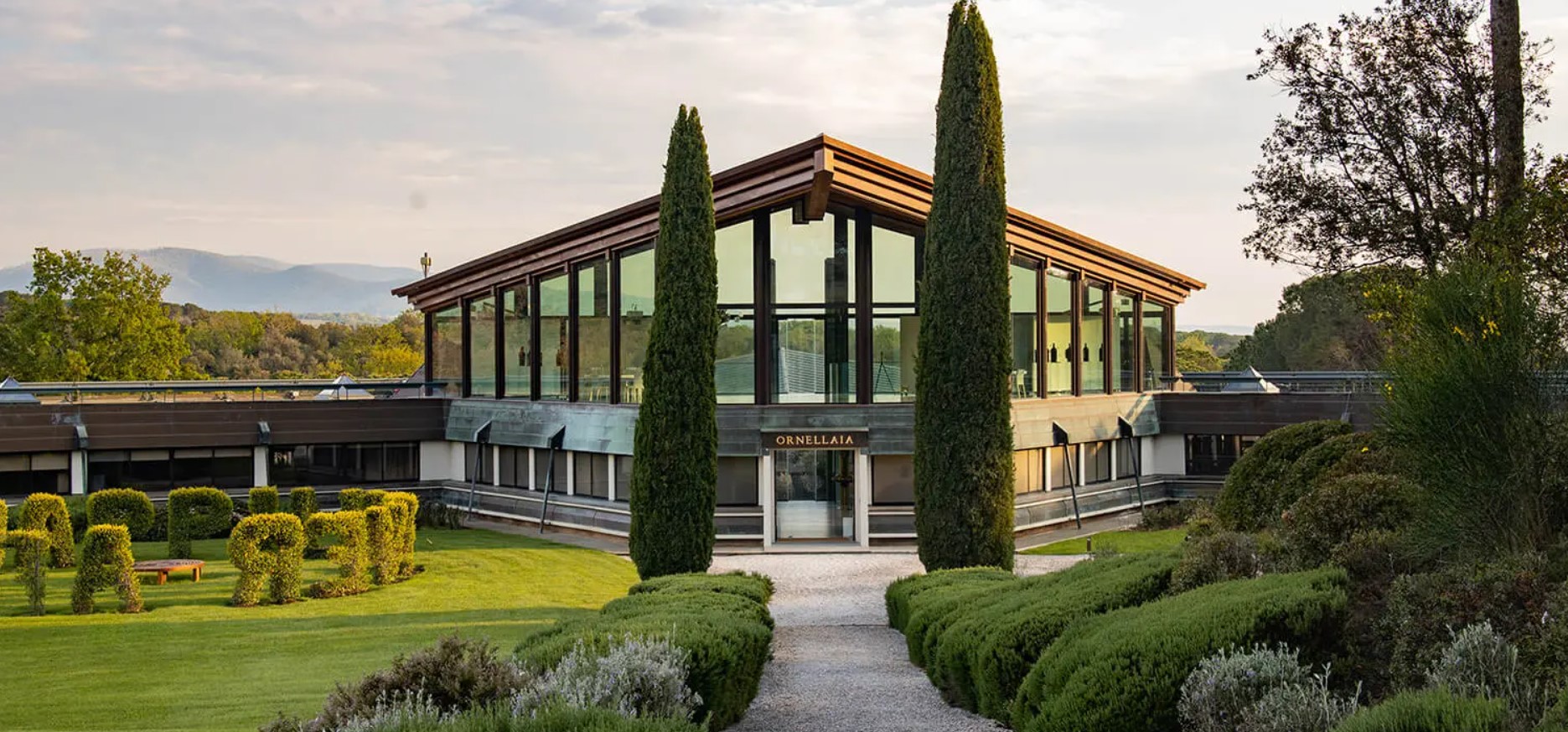
Photo credit: Ornellaia
Ah, Ornellaia! Just saying the name evokes a sense of elegance, artistry, and an unbreakable bond with its Bolgheri roots. Established in 1981, Ornellaia has swiftly ascended the ranks of the wine world, driven by a passionate quest for excellence that started with its inaugural vintage in 1985. Let me take you on a journey through the essence of this remarkable estate, where the rich soil meets the sky and a commitment to quality reigns supreme.
Why Visit Ornellaia?
Owned by the Frescobaldi family, who have been winemakers for over 700 years, Ornellaia stands as a testament to the family’s pursuit of excellence and deep respect for tradition. Marchese Ferdinando Frescobaldi leads this narrative, supported by Giovanni Geddes da Filicaja, the CEO since 1999. Together, they have shaped Ornellaia into a name synonymous with Italian lifestyle and elegance.
Located between the Tuscany hills and the Mediterranean coast, the estate benefits from unique climatic and geological conditions that create exceptional wines. The land tells its own story—once submerged under the sea, it now boasts a rich tapestry of sand, marl, and marine fossils, creating a complex terroir perfect for growing grapes.
What to Do at Ornellaia
Here are some of the things to do when visiting Ornellaia:
- The Vendemmia d’Artista Experience: This unique experience is a celebration of the character of each vintage. During your visit, you’ll explore the interplay of art and wine, as artists bring their interpretations to life through captivating installations scattered throughout the estate.
- The Ornellaia Wine Dinner: If you’re looking for a truly immersive experience, the Ornellaia Wine Dinner is a must.
- The Ornellaia Picnic: For a more relaxed experience, why not indulge in a gourmet picnic? Under the shade of the ancient Bellaria oak tree, you’ll enjoy a selection of local delicacies paired with the estate’s delightful wines.
- The Ornellaia Vintage Experience: Wine enthusiasts will appreciate the Vintage Experience, which offers a deep dive into the estate’s history and production philosophy. This is where you can taste a selection of different vintages, experiencing firsthand how Ornellaia’s style has evolved over the years.
What Wines to Try at Ornellaia
Now, let’s get to the heart of the matter—the wines!
- Ornellaia Bianco Bolgheri DOC: Crafted alongside the flagship red, this white wine captures the essence of the Bolgheri terroir. It’s a stunning Sauvignon Blanc. Expect a straw-yellow hue with aromas of apricots, acacia flowers, and roasted hazelnuts. It’s refreshing yet full-bodied, making it an excellent companion to seafood dishes or light pasta.
- Ornellaia Bolgheri DOC Superiore Rosso: This is the flagship wine, a masterful blend of Cabernet Sauvignon, Merlot, Cabernet Franc, and Petit Verdot. The 2021 vintage particularly stands out, with notes of Mediterranean herbs, blackberry, and dark fruits. The palate is rich and velvety, with dense tannins that give way to a vibrant finish. This wine is perfect for those who appreciate complexity and elegance.
- Le Serre Nuove dell’Ornellaia: Don’t overlook this proud second wine. It embodies the same philosophy as the flagship but offers a unique perspective on the estate’s character. The 2022 vintage displays fresh black fruit, spices, and a juicy profile. It’s approachable and delightful, perfect for a casual gathering or a cozy evening at home.
Practical Tips for Visiting Ornellaia
- Book in Advance: Tours and experiences are by appointment only, so be sure to reserve your spot ahead of time.
- Dress Comfortably: You’ll be walking through vineyards and possibly uneven terrain, so wear comfortable shoes. A light jacket can be handy if you’re visiting in the cooler months.
- Don’t Rush: Allow yourself enough time to truly soak in the experience. Whether it’s the art, the wine, or the scenery, take your time to appreciate every moment.
- Engage with the Staff: The team at Ornellaia is incredibly knowledgeable and passionate. Don’t hesitate to ask questions about the wines, the estate, or even the art! Their insights can enhance your experience.
- Explore the Surroundings: After your visit, consider exploring Bolgheri, a charming medieval village nearby, or enjoy the coastal views along the Mediterranean.
- Bring Home Some Wine: If you find a wine you love (and trust me, you will!), grab a few bottles to take home. Ornellaia wines are limited in production, and having a bottle on hand will remind you of your wonderful experience.
Why Tuscany is the Ultimate Wine Destination
Tuscany is synonymous with world-class wines, especially Chianti, Brunello di Montalcino, and Super Tuscans. With ancient traditions, favorable weather conditions, and diverse soils, the region produces some of the most prestigious wines in the world. Each winery has its own story, unique terroir, and winemaking philosophy, which is reflected in every glass.
From family-run estates to grand wineries with centuries of history, Tuscany offers an immersive wine experience. And let’s not forget the incredible food—Tuscany is a food lover’s paradise too.
Where to Stay in Tuscany
One of the best ways to immerse yourself in Tuscany’s wine culture is to stay at a wine estate. Not only do you get to sleep amidst the vineyards, but you also have the opportunity to enjoy exclusive wine tastings, vineyard walks, and farm-to-table meals. Here are ten incredible wineries in Tuscany that offer accommodations:
- Castello Banfi (Montalcino) – A luxurious castle estate with elegant rooms, stunning views, and an exceptional restaurant. Their Brunello wines are a highlight.
- Il Borro (Arezzo) – Owned by the Ferragamo family, this estate is a gorgeous blend of history, art, and wine. The accommodation is in a restored medieval village.
- Relais La Suvera (Siena) – This boutique hotel offers a romantic and secluded escape, with breathtaking views and intimate wine experiences.
- Borgo San Felice (Chianti) – A Relais & Châteaux property that offers both luxury accommodations and fantastic wines in the heart of the Chianti region.
- Castello di Vicarello (Maremma) – An intimate boutique hotel in a 12th-century castle, with wines produced on-site and panoramic views of the countryside.
- Tenuta di Artimino (Carmignano) – A historic estate with a beautiful Medici villa, vineyards, and a relaxing spa.
- Conti di San Bonifacio (Maremma) – A small luxury wine resort in the unspoiled region of Maremma. It’s perfect for those seeking a tranquil and exclusive wine retreat.
- Castiglion del Bosco (Montalcino) – A luxurious estate owned by the Ferragamo family, offering stunning accommodations and exclusive Brunello di Montalcino tastings.
- Villa La Massa (Chianti) – A 16th-century villa-turned-hotel located on the banks of the Arno River. It’s just outside Florence, making it a great base for exploring the region.
- Rosewood Castiglion del Bosco (Montalcino) – Another opulent Ferragamo estate, known for its exclusive wines, luxurious accommodations, and breathtaking views.
Where to Dine in Tuscany
No Tuscan wine experience is complete without indulging in the region’s incredible food. From Michelin-starred restaurants to traditional trattorias, here are my top picks for where to dine in Tuscany.
- Osteria di Passignano (Chianti) – Located next to the Antinori family’s abbey, this Michelin-starred restaurant offers farm-to-table dining with exquisite wine pairings.
- La Tenda Rossa (San Casciano) – A Michelin-starred restaurant serving creative Tuscan cuisine in a cozy, intimate setting.
- Ristorante Il Falconiere (Cortona) – A Michelin-starred restaurant set in a beautiful Relais & Châteaux property, with dishes that reflect the rich culinary traditions of the region.
- Enoteca Pinchiorri (Florence) – A three-Michelin-starred institution, Pinchiorri offers an unparalleled fine dining experience with one of the best wine lists in Italy.
- La Torre (Siena) – Located in the luxurious Castello del Nero hotel, La Torre is a Michelin-starred restaurant that celebrates local ingredients and traditional flavors.
- Il Canto del Maggio (Arezzo) – A rustic, family-run restaurant that serves seasonal Tuscan dishes made with love. The views from the terrace are stunning.
- La Bottega del 30 (Chianti) – A Michelin-starred restaurant with a romantic ambiance, offering a tasting menu that showcases the best of Tuscan cuisine.
- Trattoria Mario (Florence) – A no-frills, family-run trattoria in Florence, serving hearty Tuscan dishes at reasonable prices. Their bistecca alla fiorentina is legendary.
- Arnolfo (Colle di Val d’Elsa) – This two-Michelin-starred restaurant offers contemporary Tuscan cuisine in a beautiful medieval town.
- La Grotta (Montepulciano) – Located near the iconic San Biagio church, La Grotta serves traditional Tuscan dishes in a cozy and elegant setting.
Travel Tips for Visiting Tuscany
- Rent a Car: Tuscany is best explored by car, especially if you want to visit wineries. Public transportation is limited in rural areas, so renting a car will give you the flexibility to explore at your own pace.
- Plan Your Winery Visits: Many wineries require reservations for tours and tastings, so it’s essential to book ahead, especially during the busy summer months.
- Timing Your Visit: The best time to visit Tuscany for wine tasting is during the fall harvest (September to October). The weather is perfect, and the vineyards are alive with activity.
- Stay in the Countryside: While Florence and Siena are beautiful, I recommend staying in the countryside to get the full Tuscan experience. There’s nothing like waking up to the sound of birds and the sight of vineyards stretching out before you.
- Wine Shipping: Most wineries offer international shipping, so if you fall in love with a bottle (or ten), you can have them shipped home without worrying about carrying them back.
How to Choose the Best Wine in Tuscany?
One of the most enjoyable things about visiting Tuscany is tasting the wines. With so many wineries and wines to choose from, it can be challenging to pick the right wine. Here are some tips for choosing the best wine:
- Start with the Basics: It’s best to start with the basics by trying the most popular wines in Tuscany, such as the Chianti and Brunello di Montalcino wines. These wines are widely available, and you’ll be able to find them in most wineries and restaurants.
- Explore Different Wineries and Regions: Try to visit different wineries and regions in Tuscany to get a better understanding of the different winemaking techniques used in the region. Each winery has its unique flavor and personality.
- Take Note of the Labels: It’s essential to read the labels to understand the grape variety, the wine’s aging, and other information. This information will help you decide which wine to choose according to your taste.
- Trust Your Taste Buds: When it comes down to it, the best way to choose the best wine in Tuscany is to trust your taste buds. Everyone has different preferences, and it’s essential to choose a wine that you personally enjoy.
The Best Food Pairing for Tuscan Wines
Tuscan wines are best paired with Tuscan cuisine. The region is known for its rich and flavorful dishes that complement the wines perfectly. Here are some food pairing suggestions:
- Chianti and Steak: The bold and intense taste of Chianti wine pairs well with a juicy steak. The steak needs to be cooked to perfection, served with a side of roasted potatoes and vegetables.
- Brunello di Montalcino and Wild Game: Brunello di Montalcino wine has a complex flavor and aroma that pairs well with game meat such as wild boar or venison. Serve the meat with polenta or roasted root vegetables.
- Vernaccia di San Gimignano and Seafood: Vernaccia di San Gimignano is a crisp and refreshing white wine that pairs well with seafood. Serve with a seafood pasta dish or grilled fish with butter sauce.
- Vin Santo and Cantuccini: Vin Santo is a sweet dessert wine made from dried grapes. It’s best paired with cantuccini, traditional Tuscan biscotti that are perfect for dipping in Vin Santo.
The Best Time of Year to Visit Tuscan Wineries
Tuscany is a beautiful region to visit all year round, but the best time to visit the wineries is during the harvest season.
- Harvest Season (September – October): The harvest season is the best time to visit Tuscan wineries. It\’s a time when the vineyards are bustling with activity, and visitors can experience the traditional winemaking process. Harvest season in Tuscany is usually from September to October.
- Spring (April – May): Spring is an excellent time to visit Tuscan wineries. The vineyards are blooming with new life, and the weather is mild and pleasant. There are fewer crowds, and visitors can take their time to explore the wineries and taste the wines.
- Winter (December – February): Winter is a quiet season in Tuscany, and wineries offer unique experiences such as truffle hunting and wine blending activities. Visitors can avoid crowds during this season and enjoy the peaceful landscape of the Tuscan countryside.
- Summer (June – August): Summer in Tuscany is bustling, and wineries are crowded with tourists. Despite the crowds, the weather is perfect, and visitors can enjoy outdoor activities and wine tastings. It\’s essential to book in advance to avoid long queues.
Final Thoughts
When it comes to the rich heritage of Tuscany, few regions can compete with its allure. For more recommendations, we suggest reading the article about the most prestigious wineries in Florence. Plus, for even more tips on immersing yourself in the local wine culture, check out our articles on the coolest cooking classes and wine pairings in Tuscany.
If you’re looking to bring home some treasures from your trip, our guide to the best wine shops and best wine bars will help you find the perfect bottles. And if you’re considering a longer stay, we’ve covered the best wineries to stay in Tuscany, along with cozy Tuscany villas near wineries for the ultimate getaway experience.
So, raise a glass to your next adventure in Tuscany, and enjoy all the magic this extraordinary region has to offer! Cheers! 🍷

